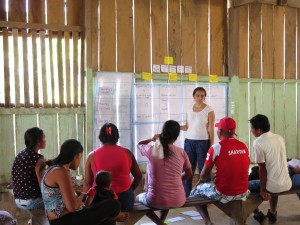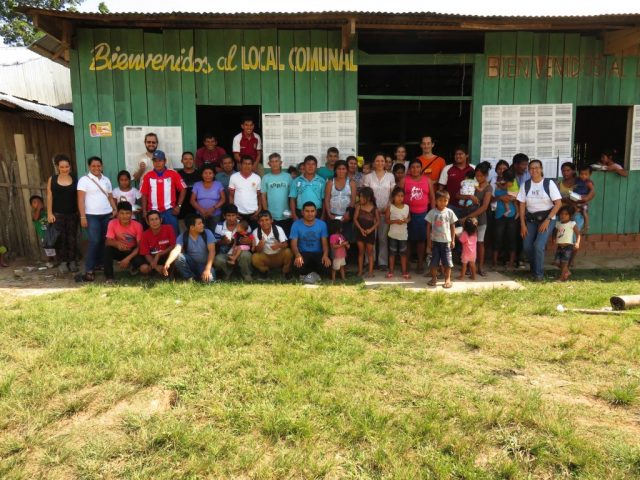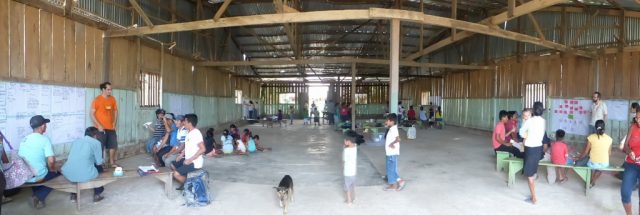“You will have to drink masato¹ in most of the communities, moreover when they are native communities, it is a sign of welcome, so you must not refuse it!!!”
The instructions from our partner before arriving were clear. “And don’t give back the bowl the right side up but upside-down otherwise they will serve you again…” If there was something that rose curiosity to the ecosystem services social team before leaving for the field: that was the masato.
As part of the Sustainable Amazonian Landscapes project (SAL), last month of September the ecosystem services social science team had an appointment with mestizos and indigenous communities from the Yurimaguas district, Loreto department, Peruvian Amazon. This region is at the forest-agriculture interface. In other words, it is characterized by a considerable amount of land-uses: pisciculture (fish farming), livestock farming, African palm oil and palm heart production, rice production, woods extraction… And to add to the complexity of the study area, we faced a patchwork of sociologic profiles such as long-time mestizo settlers, migrants from the cordillera, natives’ migrants, non-migrant natives… A true mosaic of the deforestation front!!

Land uses of the study area in Perú
Together with local partners, Instituto de Investigaciones de la Amazonia Peruana and Universidad de La Molina, and in collaboration with Universidad Nacional de la Amazonia Peruana we held participatory rural appraisal workshops (PRA) in seven communities in order to learn their distinct realities. We co-designed a manual to help every partner follow the development of the participatory methods. The manual explained the general logistics but also the detailed processes of each exercise: well-being discussion; matrices about climate change perceptions, adaptation strategies and land-uses; card techniques about the use of flora and fauna; cause-effect diagrams about climate change and deforestation. But a manual is not always the best manner of disseminating knowledge, so we conducted a three-day workshop in order to train every co-worker (15 persons) as facilitators or note-takers. This helped them to understand the organization, logistics, duration and the work required for each discussion designed. Furthermore, they could grasp the difficulties and challenges of making people speak-up and interact during participative appraisals. Some of our partners warned us that it would be difficult to make local people speak, especially in the native communities.
By then we have conducted 7 exercises in parallel per community in Caquetá, we are trained, and we have good partners: “challenge accepted” (Stinson B, 2005-2014). Let’s see now how it happened in one community:
A kinda “storytelling”: in the community of Santa Lucia (native migrants), day 8
6:00 am – the hotel: we all meet slowly in the eating room for a quick breakfast. We are leaving in 30 min. We need to make a fast cross-check that we didn’t forget anything. Discussion of the morning: “1st native community…””you think they’ll serve us masato?””Naahh!!! They are living close to a road, they must have forgotten this tradition, right??…. Yeah, sure [trembling voice]?!!?!!”
6:30 am – the road: as we have only two trucks and we are 14 people, some people have to go in the roofless “back” of the truck…but that is not a problem, the road to Santa Lucia is in good shape. Or at least that is what we thought. Long story short: the people in the back should not have taken a shower.
Sometime between 7:30 and 8:00 – community center: let’s start the workshop!!! Wait a minute, first we are going to eat. Again? Yes, this time there is enough food for everybody. Ok then, nothing better than starting a workshop with two breakfasts (one with fish, rice and cassava) and a room with zinc roof and no air circulation. After breakfast we have what will become our daily “fight” over who will take the best spot in the room (as the focus groups are done in parallel), meaning the one spot where the breeze is not a stranger.
After breakfast: all our fears disappeared as soon as the local leader introduced us to the community and they showed us their gratitude for including them in this round of workshops, because as the leader said,…”nobody has come before to hear them out”.
9:30 am – community center: let’s rock! sorry, I mean work, let’s work! After a few days of doing these workshops in other communities everything is in place, everybody knows what to do…even the zinc roof carries out its customary function (making us sweat!).

Exercise Perception of Climate Change
The first round finishes at about mid-day, and against all predictions, the people participated actively, men and women alike. They shared with us things like “we had ourselves destroyed [the forest] and thinking about our children…the new generations are the ones that will suffer [the consequences] of our acts” and “Most of us would like to reforest, the problem is that we do not have knowledge of how is it done…we need training on reforestation so we can start to do it”.
A short break and the second round starts, during this session people keep participating and sharing their concerns and hopes: “These kind of activities are very important, these activities foster the discussions within neighbors and we can learnt together how to face climate change”
3:00 pm – community center: At the end we thank everybody for their participation, some words from us and from local leaders and with a group picture we finish the day!! Well done! Now let’s get back to Yurimaguas.

Workshop participants in Santa Lucia
5:00 pm – Hotel: Happiness is in the air, we did it one more time. We arrive at the hotel; shall we go to the swimming pool? No let’s prepare everything for tomorrow and then we go swimm…ups too late! Time to eat and go to sleep because tomorrow there is another community to do research with.
A short and intense odyssey
From brainstorming to matrices, diagrams and card techniques, we made sure that our focus groups shared their knowledge, experiences and challenges of living in this part of the Amazon while keeping them awake and participating during our visit… However, it is just fair to say that most of the job was done by the participants who shared with us their stories and allowed us to understand and learn what is to be a farmer in the Loreto region. For the success of the discussion it was very important to clarify that there were not any wrong answers to the topics that we were discussing and that all the interventions were welcome. This helped the people to put aside their fears and to participate freely in the different discussions we had.

General view of the workshop in Santa Lucia
Every PRAs day was similar: expectation of the masato, stress due to the silent, incredible warmth… And it was rapid, which is not really a focus of the methodology since what matters is not really the time spent but rather the process. The effort made was fruitful: we were able to appraise the coherence of community members’ perceptions of deforestation and climate change effects, taking into consideration variability per community and per main productive activity. We could assess, as well, local knowledge on main uses of flora and fauna and appreciate the link between land-uses and indicators of well-being. As usual with this kind of methodology, it was also time to realize the distance that exists between our preconception on a situation and what is really happening: we did not have to drink masato in every community (just in one and we were not obligated to) and the people were neither very talkative nor silent, actually the dynamic was different in every focus group carried out.
Then came the reward… It was not the hotel swimming pool. During a debriefing with the regional partners, one of the executives of IIAP told us that he had had a lot of doubts regarding the capacity of participatory methods to produce coherent results within such a short time (15 days), but with what we had shown, he was impressed, and could not believe that we had gained the trust of the people so fast, even native communities, such that they shared their experiences with us. Challenge completed!!!
For more information on the SAL Project please visit:
Increasing local capacities in participatory rural appraisal methods in Caquetá, Colombia
Arranca nuevo Proyecto del CIAT: Paisajes Sostenibles para la Amazonía (SAL)
1. The masato is a fermented beverage prepared in Peru with cassava chewed by women.
This work was undertaken as part of the project “Sustainable Amazonian Landscapes” which is supported by the International Climate Initiative (IKI). The project is led by CIAT and implemented together with the Potsdam Institute for Climate Impact Research (PIK), the Center for Research on Sustainable Systems of Agriculture Production (CIPAV), Instituto Amazónico de Investigaciones Científicas SINCHI, Universidad de la Amazonía, Instituto de Investigaciones de la Amazonía Peruana (IIAP), and Universidad Nacional Agraria La Molina (UNALM).






